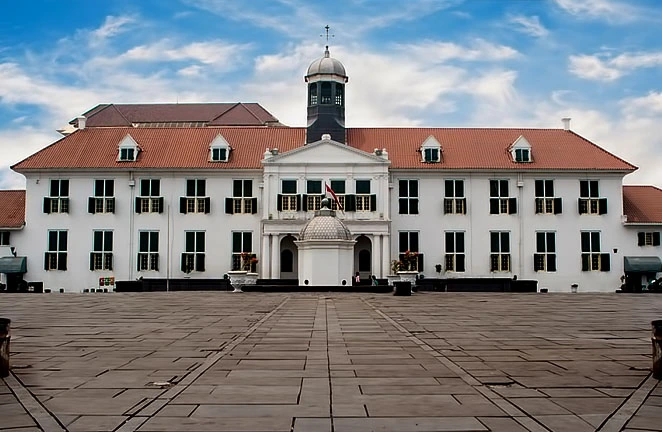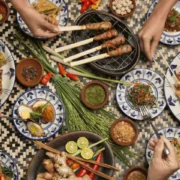
The History and Culture of Kota Tua Jakarta: A Must-Visit Heritage Site
Kota Tua is one of Jakarta’s most fascinating districts, known for its rich history and vibrant cultural significance. Located in the western part of the city, Kota Tua offers a glimpse into Jakarta’s colonial past, with its well-preserved architecture and charming historical landmarks. As you stroll through the area, you’ll encounter the essence of Jakarta’s old town, where Dutch colonial influence still stands proudly through iconic buildings and quaint squares.
Table of Contents
ToggleWhat is Kota Tua? Discover Jakarta’s Historic Old Town
Kota Tua is often referred to as the “Old Town” of Jakarta. This area, formerly known as Batavia, was once the heart of the Dutch East Indies during the 17th century. Today, it remains a vital cultural hub, featuring colonial buildings that showcase the architecture from that era. Many of these heritage areas have been preserved and transformed into museums, cafes, and cultural spaces, allowing visitors to step back in time and explore the roots of the city.
Visitors will find themselves walking through narrow streets lined with charming cafes and shops that maintain the nostalgic charm of this once-thriving colonial center. Kota Tua is the perfect destination for those interested in experiencing Jakarta’s deep historical and cultural layers while enjoying a leisurely day out.
A Stroll Through Colonial Jakarta: The Architecture of Kota Tua
The architecture in Kota Tua is a beautiful blend of Dutch colonial influence and traditional Indonesian styles. Key landmarks like Museum Fatahillah, the former City Hall, and Café Batavia exemplify the grandeur of this area. As you explore the colonial buildings, you’ll notice European architectural elements, such as large windows, high ceilings, and cobblestone streets, making it easy to imagine what life was like centuries ago.
A visit to Kota Tua isn’t just about viewing old buildings—it’s about walking through history. The area is rich with stories of the past, from the Dutch colonial era to the independence movement, and each building in the area tells its own unique story.
Why Visit Kota Tua? The Cultural Significance of Jakarta’s Old Town
Kota Tua holds great cultural significance in Jakarta’s development. It was once the center of trade, culture, and politics in the region. The district was home to various ethnic communities, including the Dutch, Chinese, and native Javanese, which is reflected in the area’s architecture, food, and traditions.
Exploring Kota Tua gives you a deeper understanding of Jakarta’s evolution from a colonial port city to the bustling metropolis it is today. It also offers a chance to witness the fusion of different cultures, making it a unique destination for history enthusiasts, photographers, and anyone interested in Jakarta’s diverse heritage.
Kota Tua is an essential part of Jakarta’s heritage. As you walk through this historical district, you’ll discover a world where the past meets the present, and every corner has a story to tell. Whether you’re a history buff, culture enthusiast, or simply looking to explore one of Jakarta’s most picturesque districts, Kota Tua offers a memorable journey into the city’s roots.
The Rich History of Kota Tua: Tracing Jakarta’s Colonial Roots
Kota Tua is a fascinating reflection of Jakarta’s history, with its roots deeply embedded in the Dutch colonial era. The district was once known as Batavia, the capital of the Dutch East Indies. Today, it stands as a testament to the city’s colonial architecture and Jakarta’s past, offering visitors a chance to explore a wealth of historical landmarks that reveal the story of the city’s transformation.
The Origins of Kota Tua: Batavia in the Dutch Colonial Era
The origins of Kota Tua date back to the 17th century when the Dutch established Batavia as a key port in their colonial empire. The area quickly became the center of trade and administration, housing Dutch settlers, merchants, and government officials. At the heart of Kota Tua is the iconic Fatahillah Square, which was once the site of the city’s bustling market and today remains a popular gathering spot for tourists and locals alike.
During this time, the Dutch constructed several monumental buildings, including forts, city halls, and warehouses, which played a crucial role in establishing Batavia as a thriving colonial hub. These buildings, with their distinct European architectural styles, form the core of Kota Tua’s colonial heritage.
Colonial Landmarks: Exploring Historical Sites in Kota Tua
As you walk through Kota Tua, the traces of its colonial past are evident in its architecture and landmarks. One of the most notable sites is Museum Fatahillah (formerly the City Hall), which offers visitors a glimpse into the history of Batavia and its significance during the Dutch rule. The museum showcases artifacts and exhibits that highlight Jakarta’s colonial past and its role in global trade.
Another key historical landmark in Kota Tua is St. Maria de Fatima Church, a beautifully preserved example of colonial-era religious architecture. The church’s intricate design and peaceful ambiance make it a popular stop for both history buffs and those seeking a moment of reflection.
Kota Tua: A Window Into Jakarta’s Past
Kota Tua is not just a collection of old buildings; it is a window into the soul of Old Jakarta. The district tells the story of how the city evolved from a trading post into a bustling metropolis, reflecting both the influence of Dutch colonialism and the resilience of the local Indonesian culture. Visitors can stroll along cobblestone streets, pass by historic shops, and marvel at the preservation of buildings that were once the backbone of Batavia.
As you explore, you’ll gain a deeper understanding of Jakarta’s transformation over the centuries. The combination of colonial architecture and local Indonesian culture makes Kota Tua one of the most culturally rich districts in the city.
Exploring Jakarta’s Colonial Legacy in Kota Tua
For those interested in Jakarta’s colonial history, Kota Tua is a must-visit destination. With its blend of historical buildings and vibrant local culture, it offers an immersive experience that brings Jakarta’s past to life. As you explore the district, you’ll uncover the stories behind the grand colonial architecture and discover the deep historical significance of the area. Whether you’re admiring the historical districts, visiting the museums, or simply enjoying the ambiance of Fatahillah Square, Kota Tua offers a unique opportunity to learn about Jakarta’s rich colonial heritage.
Walking Tour of Kota Tua: The Best Way to Discover Jakarta’s History
A walking tour of Kota Tua is one of the most immersive ways to explore this historical district, renowned for its heritage walk experiences and captivating blend of colonial architecture and cultural landmarks. Whether you’re a history enthusiast or a curious traveler, a guided tour offers the perfect opportunity to dive deeper into the stories behind Kota Tua’s rich past and vibrant present.
Why Choose a Walking Tour in Kota Tua?
A walking tour allows you to experience the charm of Kota Tua up close. The district is compact and ideal for exploring on foot, with cobblestone streets lined with colonial buildings and cultural hotspots. By strolling through its alleys, you’ll encounter well-preserved landmarks like Fatahillah Square, Museum Fatahillah, and the Kota Intan Bridge, each offering a glimpse into the district’s storied history.
Unlike other modes of exploration, a walking tour provides an intimate connection with the area’s cultural exploration. You can pause to admire intricate architectural details, interact with local vendors, and soak in the lively atmosphere that defines Kota Tua.
Highlights of a Guided Heritage Walk in Kota Tua
1. Fatahillah Square
Start your journey at Fatahillah Square, the heart of Kota Tua and a hub of activity. This iconic plaza is surrounded by historical landmarks, including the Museum Fatahillah, which was once Jakarta’s city hall during the Dutch colonial era. The square’s bustling ambiance and street performers make it a vibrant starting point for your tour.
2. Jakarta History Museum (Museum Fatahillah)
A visit to the Jakarta History Museum is a must during your walking tour. This museum houses a treasure trove of artifacts that trace the evolution of Jakarta from its days as Batavia to its present status as Indonesia’s capital. Its exhibits offer an in-depth look at Jakarta’s colonial heritage and the role Kota Tua played in shaping the city.
3. Sunda Kelapa Harbor
Continue your tour with a short walk to Sunda Kelapa Harbor, the historic port that once served as a vital trade hub for the Dutch East India Company. Here, you can witness traditional phinisi ships and gain insights into Jakarta’s maritime history.
4. Café Batavia
Take a break at Café Batavia, a legendary establishment known for its vintage interiors and colonial-era charm. Enjoy a cup of coffee or traditional Indonesian snacks while soaking in the ambiance of one of Kota Tua’s most beloved landmarks.
5. Kota Intan Bridge
End your walking tour at the Kota Intan Bridge, a well-preserved Dutch colonial drawbridge that offers picturesque views of the surrounding area. This architectural gem is a testament to the engineering prowess of the colonial era and a fitting finale to your heritage walk.
Tips for a Memorable Kota Tua Walking Tour
Taking a walking tour in Kota Tua is an exciting journey through Jakarta’s rich history, but a little preparation can make your experience even more enjoyable. Here’s an elaboration on essential tips to ensure a smooth and memorable trip:
1. Start Early
Plan to begin your tour early in the morning, ideally before 9 a.m. This allows you to explore the area while it’s still relatively cool, avoiding the scorching midday heat that Jakarta is known for. An early start also means fewer crowds, giving you the chance to take uninterrupted photos and enjoy the tranquil charm of Fatahillah Square and other landmarks. Plus, morning light enhances the beauty of the colonial architecture, making your pictures even more stunning.
2. Hire a Guide
While it’s possible to explore Kota Tua on your own, hiring a guide can significantly enhance your experience. Knowledgeable guides bring the district’s history to life by sharing fascinating anecdotes and pointing out hidden details you might otherwise miss. From the significance of Fatahillah Square to the origins of the Kota Intan Bridge, a guide ensures you walk away with a deeper appreciation of Jakarta’s colonial heritage. Look for licensed guides who specialize in heritage tours for the best experience.
3. Wear Comfortable Shoes
The cobblestone streets of Kota Tua are picturesque but can be challenging to navigate without proper footwear. Choose comfortable, supportive shoes that can handle uneven surfaces and long hours of walking. Avoid heels or slick soles, as they can make the experience uncomfortable and even unsafe. If possible, opt for breathable footwear to keep your feet cool and blister-free during Jakarta’s warm and humid days.
4. Stay Hydrated
Jakarta’s tropical climate can be draining, especially when you’re out walking for hours. Bring a reusable water bottle to stay hydrated throughout the tour. Many local vendors also sell cold drinks, but having your water ensures you won’t be caught unprepared. Consider carrying a small hand towel or a portable fan to keep yourself cool, especially if you’re visiting during the dry season when temperatures can soar.
5. Capture Memories
Kota Tua is a photographer’s dream, with its blend of colonial buildings, vibrant street life, and iconic landmarks. Bring a good-quality camera or ensure your smartphone is fully charged to capture every moment. Don’t just limit yourself to the big attractions like Fatahillah Square or Museum Fatahillah—explore the lesser-known corners and alleyways, where you’ll find unique angles and charming details. Remember to snap candid moments of local vendors, street performers, and the lively energy that makes Kota Tua so unique.
6. Dress for Comfort and Respect
Although not always mentioned, it’s essential to dress appropriately for both comfort and cultural sensitivity. Lightweight, breathable clothing is ideal for Jakarta’s humid weather, but avoid overly revealing attire to show respect for the cultural and historical significance of the area. A wide-brimmed hat, sunglasses, and sunscreen can also protect you from the sun.
7. Bring Small Cash
If you plan to enjoy street food or purchase souvenirs from local vendors, carry small denominations of cash in Indonesian rupiah. Many street vendors do not accept credit cards, and having exact changes makes transactions smoother. This also gives you the chance to try local treats like kerak telor or es kelapa muda, which add a delicious touch to your heritage walk.
By following these tips, your visit to Kota Tua will be both comfortable and unforgettable. Whether you’re marveling at the historical landmarks, indulging in local delicacies, or soaking in the bustling ambiance, you’re sure to leave with lasting memories of Jakarta’s timeless charm.
Explore Jakarta Beyond Kota Tua with the Jakarta Full Day Tour
After immersing yourself in the rich history and colonial charm of Kota Tua, why not expand your exploration to uncover more of Jakarta’s hidden gems? With the Jakarta Full Day Tour by Ekaputra Tour, you’ll have the chance to dive deeper into the city’s vibrant culture, iconic landmarks, and modern attractions—all in one comprehensive journey. This full-day experience offers a seamless blend of history, culture, and contemporary highlights, ensuring you don’t miss a thing.
From the bustling streets of Glodok to the grandeur of Monas (National Monument) and the serene beauty of Taman Mini Indonesia Indah, this tour is curated for travelers who want to see it all. Whether you’re a history enthusiast or a curious adventurer, the Jakarta Full Day Tour provides expert guides, comfortable transportation, and a detailed itinerary that guarantees a hassle-free experience. Book your tour today and turn your visit to Jakarta into an unforgettable journey!


